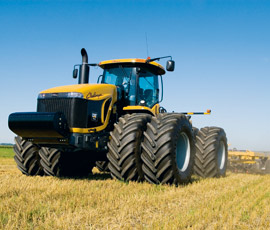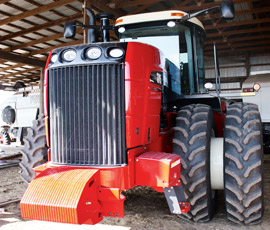What tractors farmers buy… in the USA

In the latest of our occasional looks at foreign farm machinery markets, Jodie Wehrspann from Farm Industry News gives a snapshot of farm machinery buying trends in the USA
What is the business climate for US farm machinery?
Our market has seen record sales of farm machinery in the past few years and high commodity prices have given farmers money to spend on new equipment. Adjusted for inflation, 2013’s net farm income is forecast at $128.2bn (£84.8bn), the highest since 1973.
According to the global machinery association Agrievolution Alliance, at least half of the US companies surveyed in April expect sales to grow in the next six months. The remainder expect sales to at least maintain the high level reached in 2012.
What machines are selling?
Sales have been good across the board as farmers look to update their entire fleets of equipment. Instead of buying one piece at a time, many are looking at packages of equipment.
US retail sales of combines jumped 59% in April, compared with the same month last year, according to the Association of Equipment Manufacturers. Likewise, US sales of farm tractors were up 6% for the same month.
Overall US tractor sales in 2012 amounted to 185,150 units (the equivalent figure in 2011 was 162,057), of which 92,207 had engines of less than 40hp, 54,276 had power outputs of 40-100hp and 31,732 had engines putting out more than 100hp. Big, artic-steer tractors accounted for 6,935 sales.
Combine sales in 2012, meanwhile, amounted to 9,820 units.
What technologies are helping US farmers cover the increase in acreage?
 The industry is going in two directions. One is the move to bigger machinery – 48-row planters, full-size combines, 50t grain carts, 6,000 litre sprayers with 36m booms and tractors rated at over 600hp.
The industry is going in two directions. One is the move to bigger machinery – 48-row planters, full-size combines, 50t grain carts, 6,000 litre sprayers with 36m booms and tractors rated at over 600hp.
The other direction is automation, with farms getting by with fewer operators and in some cases smaller machines that can be operated 24/7 to reduce the cost of ownership.
What are companies offering to farmers?
Here in the USA, two companies – John Deere and Kinze Manufacturing-have come out with tractors that can drive (to some extent) without a human operator. In John Deere’s case, the driver remains in the vehicle to oversee the semi-autonomous systems. A third company, the Autonomous Tractor Corp has shown its prototype Spirit tractor which has no cab.
RowBot Systems, also based in the USA, is developing autonomous ground units that are sized small to run in between rows of standing corn while applying nitrogen. Unmanned aerial vehicles, or drones, like PrecisionHawk have the potential to replace human field scouts.
Commercial use in the USA is prohibited. But the market is expected to boom with the opening of US airspace to civil unmanned aerial vehicles by the Federal Aviation Administration in 2015.
Precision farming continues to be a buzzword around the world. What’s new in that industry?
The buzzwords now are big data, or how to manage all of the geo-referenced information that farmers have collected on their fields. US companies are aggressively competing to offer products and services that help farmers manage the data using cloud-based web storage and farm management information software. Offerings are coming from every farm industry sector, including machinery companies that used to be in the business of selling iron only.
What types of tillage are practised?
Tillage methods in the USA are still divided into the major categories of conventional tillage, reduced tillage and minimum tillage, defined by the amount of crop residue they leave on the surface. But a few subcategories have taken off in the last few years. These include vertical tillage and strip tillage, both forms of reduced tillage.
What do these new forms of tillage offer US farmers?
Vertical tillage has surfaced as a way to slice through tough corn stalks left by genetically modified corn hybrids without displacing a lot of soil. About a dozen companies, including McFarlane, Salford Farm Machinery and Great Plains all offer vertical tillage implements. Some of the major manufacturers have also jumped on this market.
Strip-till, the other subcategory, is re-emerging because of the money it can save on fertiliser costs. GPS guidance has made it possible to concentrate nutrient application to narrow strips within a few inches of where the seed is planted.
Read more articles from our Foreign Fields series

